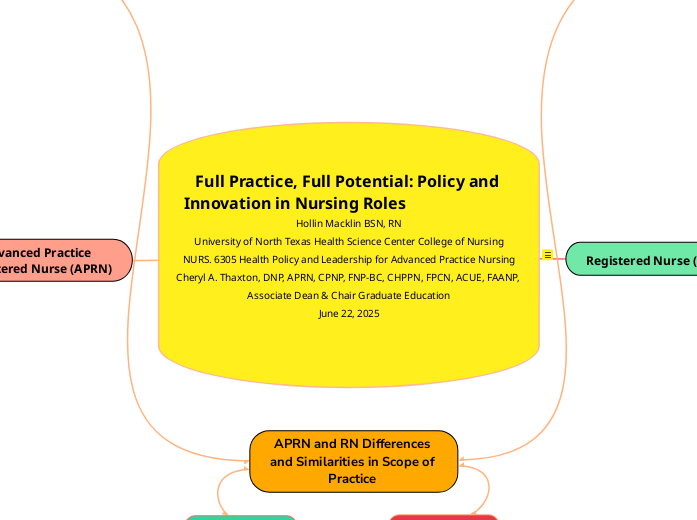Full Practice, Full Potential: Policy and Innovation in Nursing Roles Hollin Macklin BSN, RN
University of North Texas Health Science Center College of Nursing
NURS. 6305 Health Policy and Leadership for Advanced Practice Nursing
Cheryl A. Thaxton, DNP, APRN, CPNP, FNP-BC, CHPPN, FPCN, ACUE, FAANP, Associate Dean & Chair Graduate Education
June 22, 2025
Registered Nurse (RN)
Provides direct care under supervision of APRNs or physicians
Administers medications, monitors vital signs, and offers emotional and educational support
Cannot diagnose conditions or prescribe medications
Requires: ADN or BSN
Integral in patient care coordination and advocacy
Legal: Scope-of-practice statutes limit autonomous roles (Baker & Williams, 2016)
Regulatory: Inconsistent national licensure and lack of privileging policies (Feringa et al., 2018)
Institutional: Hospital policies limit RN protocol use and nurse-initiated care pathways (Kleinpell et al., 2022)
Present patient safety and quality metrics tied to RN-led interventions
Collaborate with hospital boards and quality councils
Use ANA’s Healthy Nurse Healthy Nation and Future of Nursing framework as leverage
Addressing Rural & Underserved Needs (RN) (Yates et al., 2022)
Empower nurse-led clinics and home visit models
Train RNs from rural communities through targeted pipeline programs and scholarships
Emphasize care coordination and chronic disease management
Support legislation recognizing RN clinical decision-making authority
Policy/Organizational Changes & Advocacy (RN) (Chiu, Cummings, Thorne, & Schick-Makaroff, 2021; Rash, 2024; Sutor & Painter, 2020; Ferguson, 1998)
Support legislation recognizing RN clinical decision-making authority
Develop rural RN advocacy fellowships and legislative internships
Use data dashboards to highlight RN shortages and outcomes
Launch storytelling campaigns through the Campaign for Action
Expand BSN-preparation mandates and create RN residency programs
Advanced Practice Registered Nurse (APRN)
Includes 4 Main Roles
Nurse Practitioner (NP)
Certified Nurse-Midwife (CNM)
Certified Registered Nurse Anesthetist (CRNA)
Clinical Nurse Specialist (CNS)
Can diagnose, prescribe, and can independently manage care
Authorized for independent practice in 26 states
Requires a Master's or Doctoral degree
Emphasizes evidence-based practice, leadership, health policy, and systems-level care
Legal: SOP laws require physician collaboration in many states (Peterson, 2017; Hain & Fleck, 2014)
Regulatory: Inconsistent certification, privileging, and transition-to-practice mandates (Feringa et al., 2018; Kleinpell et al., 2023)
Institutional: Restrictions on prescriptive authority, hospital admitting, and billing (Kleinpell et al., 2022; Barton et al., 2021)
Leverage data showing APRN cost-effectiveness and quality outcomes
Engage through national policy briefings and interprofessional forums
Leverage AANP, ANA, and interdisciplinary coalitions
Expand telehealth and remote prescribing services
Launch APRN residency programs in rural FQHCs
Build community trust and retention through culturally responsive care
Push for APRN Compact legislation for multi-state practice
Promote standardization via the APRN Consensus Model
Use FTC and CMS data to advocate for removal of anticompetitive policies
Expand CMS reimbursement rules and hospital privileging reforms
Empower APRN students through policy fellowships and media training
